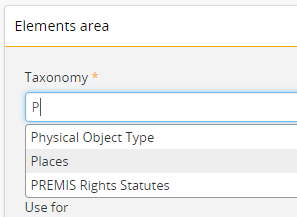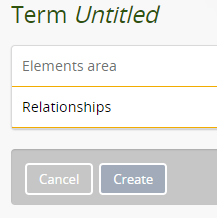| Table of Contents |
|---|
Introduction
...
- The Archives Catalogue includes a taxonomy of more than 1,600 geographic place access points that support browsing, faceted browsing, and advanced searching.
- During archival processing or digitization, Archives staff convert verbatim locality information into standardized geographic place access points. Archives staff gather standardized terms from the Library of Congress Subject Headings database (LCSH).
- If LCSH does not include a standardized form of the geographic location, Archives staff construct an access point in accordance with the rules prescribed in Chapter 23 of the Rules for Archival Description.
- The Libraries also uses select places taxonomy data to:
- Maintain the /wiki/spaces/APM/pages/85688440 embedded in the Archives Catalogue.
- Help generate Darwin Core metadata for cataloguing herbarium specimens and other biodiversity material.
- Maintain the /wiki/spaces/APM/pages/85688440 embedded in the Archives Catalogue.
Create a new geographic place access point in the Archives Catalogue
...
| Tip | ||
|---|---|---|
| ||
See the official Access to Memory (AtoM) documentation on adding geographic place names. |
Only editors and administrators of the Archives Catalogue can create new geographic place access points.
- Click on the Add menu and select "Terms":
- Select Places from the drop-down list of taxonomies.
- Geographic place access points can also be created by clicking on the "Add new" button at the bottom of the "Browse Places" page.
- Complete the data entry form. Refer to the following metadata guidelines.
- Click on the "Create" button to save the new access point.
Taxonomy
...
| Information element | Taxonomy |
|---|---|
| Darwin Core element | |
| Required | Mandatory |
| Repeatable | No |
| Guidance | Select the Places taxonomy from the auto-complete list. |
| Examples | Places |
...
| Information element | Use for |
|---|---|
| Darwin Core element | |
| Required | Optional |
| Repeatable | Yes |
| Guidance | Optionally, enter one or more non-preferred terms. Recommended practice is to add UF terms when they are present in the LSCH record. |
| Examples | Bombay (India) (use for Mumbai (India)) Frobisher Bay (N. T.) (use for Iqaluit (Nunavut)) |
Code
...
| Information element | Code | |||||
|---|---|---|---|---|---|---|
| Darwin Core element | dwc.decimalLatitude dwc.decimalLongitude | |||||
| Required | Mandatory | |||||
| Repeatable | No | |||||
| Guidance | Use one of the following tools to determine the decimal coordinates for the geographic place:
Enter the coordinates of the place in decimal degree format:
| |||||
| Examples | 63.733333, -68.5 60, -96 |
Scope note(s)
...
| Information element | Scope note(s) |
|---|---|
| Darwin Core element | |
| Required | Do not use |
| Repeatable | No |
| Guidance | Do not use |
| Examples | N/A |
...
| Information element | Source note(s) |
|---|---|
| Darwin Core element | dwc.georeferenceSources |
| Required | Mandatory |
| Repeatable | Yes |
| Guidance | Provide references to maps, gazetteers, or other resources used to georeference the locality, described specifically enough to allow anyone in the future to use the same resources. If multiple sources were used, provide references to each source. |
| Examples | National Geospatial-Intelligence Agency. "GeoNames WMS Viewer." Accessed June 18, 2018. http://geonames.nga.mil/namesviewer/default.asp. Natural Resources Canada. "Canadian Geographic Names Database." Accessed June 18, 2018. http://www4.rncan.gc.ca/search-place-names/search?lang=en. U.S. Geological Survey. "Earth Explorer." Accessed June 18, 2018. https://earthexplorer.usgs.gov/. |
...
| Information element | Display notes(s) |
|---|---|
| Darwin Core element | |
| Required | Do not use |
| Repeatable | No |
| Guidance | Do not use |
| Examples | N/A |
Broad term
...
| Information element | Broad term |
|---|---|
| Darwin Core element | |
| Required | Mandatory |
| Repeatable | No |
| Guidance | Continents are the broadest terms in the taxonomy. Use counties as broader terms for municipalities located within Nova Scotia. Use provinces, territories, or states as broader terms for municipalities found elsewhere in Canada or within the United States. Use countries as broader terms for municipalities located in other countries. Enter the broader term for the geographic place, as follows:
|
| Examples |
...
| Information element | Related term(s) |
|---|---|
| Darwin Core element | |
| Required | Do not use |
| Repeatable | No |
| Guidance | Do not use |
| Examples | N/A |
Converse term
...
| Information element | Converse term |
|---|---|
| Darwin Core element | |
| Required | Do not use |
| Repeatable | No |
| Guidance | Do not use |
| Examples | N/A |
Add new narrower terms
...
| Information element | Add new narrower terms |
|---|---|
| Darwin Core element | |
| Required | Do not use |
| Repeatable | No |
| Guidance | Do not use |
| Examples | N/A |
Example: Mumbai (India)
...



